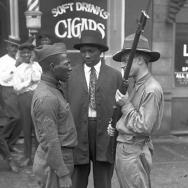July 27, 1919 was a hot day in Chicago. That afternoon, 17-year-old Eugene Williams was swimming at a public beach when he drifted across an invisible color line extending into Lake Michigan. White beachgoers began throwing stones at him, and Williams drowned.
The event sparked a week of violent unrest across the city that reverberated for decades to come. Yet it was a moment that few people, including University of Chicago sociologist and Assoc. Prof. Eve L. Ewing, knew much about.
“I am a born-and-bred Chicagoan. I am nerdy about Chicago history, especially Black history,” Ewing said, who first learned about Williams’ story in graduate school. “I read a lot. If I don't know this, that's real bad.”
During an Oct. 12 conversation with WBEZ’s Sasha-Ann Simons at UChicago’s Logan Center for the Arts, Ewing emphasized that learning about an important historical event for the first time isn’t a cause for shame. “It is a moment to ask yourself: ‘Who is invested in your not knowing? What systems are perpetuated by your not knowing?’”
Three years ago, Ewing published 1919, a collection of poetry that examined the race riots in Chicago. That same summer, racial tensions erupted in dozens of U.S. cities—a period which became known as “The Red Summer.” Ewing’s poems have recently been adapted in a new play at the Steppenwolf Theatre aimed at teaching young adults in particular about this difficult chapter in Chicago history—and how it shaped Chicago’s racial geography.
“1919 is a time when people lost their lives for absolutely no good reason, and there were no heroes or happy endings,” Ewing said. “It was just a bad thing that happened.”
Time is a circle
Early on in 1919, a character says: “This story didn’t start with Eugene Williams, and it doesn’t end with him.”
Both the show and its source material embrace the idea that history is cyclical and non-linear. In one moment, the audience is on the beach watching people dive for Williams’ body. In another, they are watching sharecroppers debate staying in the Jim Crow South or heading north to an unknown future in Chicago—a choice many Black Americans faced in the early 20th century.
For Ewing, a scholar in UChicago’s Department of Race, Diaspora and Indigeneity, poetry allowed her to create emotional entry points into history. “What is happening in people's hearts when they set out for a new place? What is the fear that they have to overcome, and what is the hope that drives them?” asked Ewing. “To me, that's the core of this story.”
Each poem of 1919 is in direct conversation with a passage from a 1922 report called The Negro in Chicago: A Study of Race Relations and A Race Riot. Ewing came across the document while researching housing segregation for her book Ghosts in the Schoolyard. The purpose of the 600-page report was to find the root cause of the 1919 riots and propose solutions to prevent anything like them from happening again.
Ewing was struck not only by the evocative language in this official document, but also by the parallels to today’s Chicago. Here was a report written 100 years ago, yet so many of the problems sounded familiar: segregation, police brutality, underfunded schools and housing insecurity.
The play embraces these parallels by touching on more recent events like the Chicago riots of 1968 and the police shooting of Laquan McDonald in 2014.
“We look around the city, and we see these things as though they just happened,” said Ewing. “And it didn't happen like that! There are people and policies and institutions and histories that led us to this moment.”
For young adults
Chicago playwright J. Nicole Brooks tackled the challenge of adapting a dark, sensitive history into something for teens. Following the lead of its source material, 1919 is sometimes abstract and dreamlike; other times, it’s sharp and funny—serving Flamin Hot Cheetos-obsessed characters alongside moments of grief.
Under the co-direction of Tasia A. Jones and the Court Theater’s Gabrielle Randle-Bent, the heavy subject matter is counterbalanced by vibrant and physical performances. The play is performed in the round with a cast of six morphing characters who jump rope, skate and footwork across the stage.
At times, it’s hard to stomach that the violence and death depicted is for a young audience. But, then again, the person at the center of this story—Eugene Williams—was only 17.
During a Q&A at the event, a young audience member asked Ewing: “What made you want to write about Eugene Williams?”
Ewing responded that she hoped to take a moment to mourn Williams and invite others to join her.
“Mourning somebody means allowing yourself to feel sad because, even though being sad is uncomfortable and hard sometimes, it also means you loved them. It also means you are remembering them,” she said. “I think that everybody who is lost deserves mourning. Everybody who is lost deserves to be remembered.”
Starting in November, 1919 will go on tour. The show will be performed in several venues around the city as part of Chicago Park Districts' Night Out in the Parks program. A workshop for teens will be held before each performance.
—1919 will run through the end of the month with several weekday matinee performances for students and teachers. For more information, visit the Steppenwolf Theatre website.

